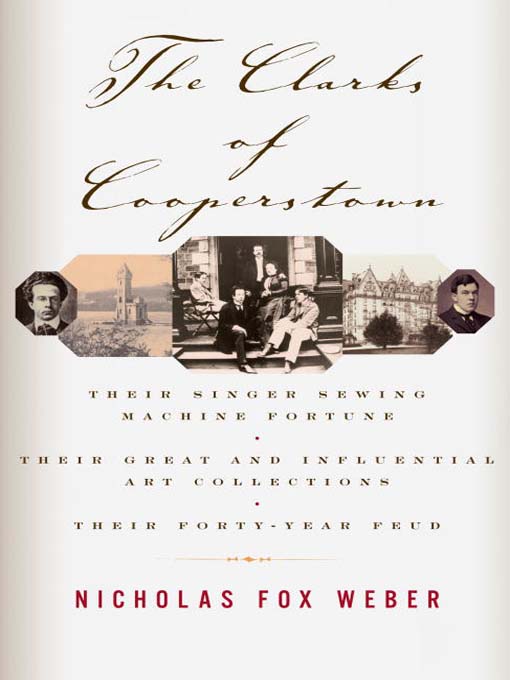He begins with Edward Clark—the brothers’ grandfather, who amassed the Clark fortune in the late-nineteenth century—a man with nerves of steel; a Sunday school teacher who became the business partner of the wild inventor and genius Isaac Merritt Singer. And, by the turn of the twentieth century, was the major stockholder of the Singer Manufacturing Company.
We follow Edward’s rise as a real estate wizard making headlines in 1880 when he commissioned Manhattan’s first luxury apartment building. The house was called “Clark’s Folly”; today it’s known as the Dakota.
We see Clark’s son—Alfred—enigmatic and famously reclusive; at thirty-eight he inherited $50 million and became one of the country’s richest men. An image of propriety—good husband, father of four—in Europe, he led a secret homosexual life. Alfred was a man with a passion for art and charity, which he passed on to his four sons, in particular Sterling and Stephen Clark.
Sterling, the second-oldest, buccaneering and controversial, loved impressionism, created his own museum in Williamstown, Massachusetts—and shocked his family by marrying an actress from the Comédie Française. Together the Sterling Clarks collected thousands of paintings and bred racehorses.
In a highly public case, Sterling sued his three brothers over issues of inheritance, and then never spoke to them again.
He was one of the central figures linked to a bizarre and little-known attempted coup against Franklin Delano Roosevelt’s presidency. We are told what really happened and why—and who in American politics was implicated but never prosecuted.
Sterling’s brother—Stephen—self-effacing and responsible—became chairman and president of the Museum of Modern Art and gave that institution its first painting, Edward Hopper’s House by the Railroad. Thirteen years later, in an act that provoked intense controversy, Stephen dismissed the Museum’s visionary founding director, Alfred Barr, who for more than a decade had single-handedly established the collection and exhibition programs that determined how the art of the twentieth century was regarded.
Stephen gave or bequeathed to museums many of the paintings that today are still their greatest attractions.
With authority, insight, and a flair for evoking time and place, Weber examines the depths of the brothers’ passions, the vehemence of their lifelong feud, the great art they acquired, and the profound and lasting impact they had on artistic vision in America.
-
Creators
-
Publisher
-
Release date
March 11, 2009 -
Formats
-
Kindle Book
-
OverDrive Read
- ISBN: 9780307494528
-
EPUB ebook
- ISBN: 9780307494528
- File size: 9770 KB
-
-
Languages
- English
-
Reviews
-
Publisher's Weekly
March 12, 2007
Curator and writer Weber (Balthus
) tells the fascinating story of an art-obsessed family—especially Sterling and Stephen Clark, whose affinity with artists, says Weber, went beyond the usual collector's. The family fortune was founded by Edward Clark, as the business partner of sewing machine mogul Isaac Singer. His son Alfred used his inheritance to support the sculptor George Grey Barnard and the piano prodigy Josef Hofmann. Sterling and Stephen were Alfred's sons. Sterling was a brash bon vivant who married a French actress and took part in an abortive movement to depose President Franklin D. Roosevelt, whose policies he believed were destroying America's capitalist economy. He also built a museum in Williamstown, Mass., to house his extraordinary collection of Courbets, Renoirs and others. Stephen, a founder of the National Baseball Hall of Fame and Museum in Cooperstown, N.Y., was reserved and dour, yet adventurous as an art collector, buying the works of avant-garde artists like Van Gogh, Picasso and Brancusi. One of the founding trustees of the Museum of Modern Art, he stirred up controversy when he fired the museum's first director, Alfred Barr. Weber's delightfully written study includes much insightful psychological speculation about these larger-than-life men. (An exhibit abut Sterling and Stephen Clark and their collection will be at the Metropolitan Musem of Art in New York City May 22–Aug. 19.) 16 pages of color illus., b&w photos throughout. -
Booklist
Starred review from April 1, 2007
The Clark family helped shape American commerce and culture, yet their saga is little known. Weber (Balthus, 1999) portrays the Clarks with splendid animation and a deep understanding of the passion for art. Attorney Edward Clark amassed the considerable family fortune by shrewdly managing Isaac Singers sewing-machine company, and built New Yorks famed Dakota apartment building. His son and heir, Alfred, lived a carefully divided life as husband to an exceptional woman, father of four sons, and a man who loved men. Two of his sons inherited Alfreds devotion to art and largesse. Audacious and macho Sterling was a pleasure seeker and a fanatic collector. The owner of 39 Renoirs, he built the renowned Sterling and Francine Clark Art Institute in Massachusetts. Sadly, his over-the-top emotions instigated a decades-long estrangement from his brothers. Proper and hardworking philanthropist Stephen was a quietly brilliant collector (Edward Hopper was a favorite). Instrumental in establishing New Yorks Museum of Modern Art, he also built the Baseball Hall of Fame. Webers exquisitely sensitive yet hugely entertaining group portrait of the Clarks is a potent tale of family and wealth, anguish and the solace of art.(Reprinted with permission of Booklist, copyright 2007, American Library Association.)
-
Formats
- Kindle Book
- OverDrive Read
- EPUB ebook
subjects
Languages
- English
Loading
Why is availability limited?
×Availability can change throughout the month based on the library's budget. You can still place a hold on the title, and your hold will be automatically filled as soon as the title is available again.
The Kindle Book format for this title is not supported on:
×Read-along ebook
×The OverDrive Read format of this ebook has professional narration that plays while you read in your browser. Learn more here.


